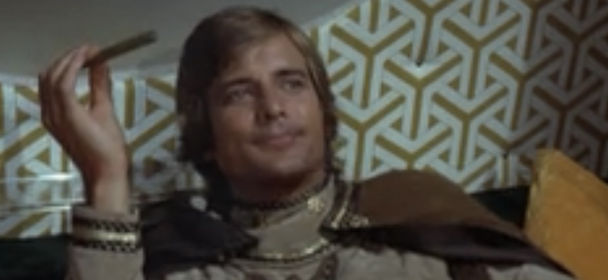Battlestar Galactica
Season 1, Episode 7: “The Long Patrol”
Original airdate: October 15, 1978
Reesav: After enjoying a couple of remarkable entries in our space opera roundtable, courtesy of Star Trek and Doctor Who, it seemed inevitable that one of the later contributions would fall short of excellence.
To be candid, describing the original Battlestar Galactica as “less than excellent” might be one of the more generous ways to assess it.
This series, which served as the precursor to the franchise with the same name and served as the inspiration for the critically acclaimed 2004 reboot, had its moments.
“The Long Patrol,” an episode written by Donald Bellisario (who later went on to create iconic series like Magnum: P.I., Airwolf, and the last show people seem to watch live, NCIS), places the Colonial Fleet on the verge of their known space, preparing to venture into a new galaxy after the annihilation of their old world.
Ace pilot Starbuck, portrayed by Dirk Benedict (known for his role as Templeton “Face” Peck in The A-Team), embarks on a scouting mission in an experimental Viper plane, only to find himself at the mercy of a smuggler dealing in this universe’s equivalent of single-malt scotch.
The plot effectively establishes the high stakes, but it leaves many questions unanswered regarding why the fleet is out there and the precise nature of the threat posed by the Cylons.
As I haven’t had the opportunity to view the early episodes, I’m unsure about the level of serialization intended for the show, and it’s possible that they addressed these matters in the early episodes.
Galactica undoubtedly faced its fair share of criticism for being labeled as a Star Wars imitation (in fact, Universal was sued by 20th Century Fox for copyright infringement during the filming of Empire Strikes Back).
It’s not difficult to understand why. The series premiered in 1978, just a little over a year after the debut of Star Wars, and you can unmistakably spot the influence of the latter in Battlestar’s overall aesthetic.
The sounds of spaceflight and laser battles bear more than a passing resemblance, the Viper craft is undeniably inspired by the X-wing, and even Apollo’s attire and Starbuck’s haircut evoke memories of Han Solo and Luke Skywalker, respectively.
Nevertheless, these similarities don’t particularly bother me.
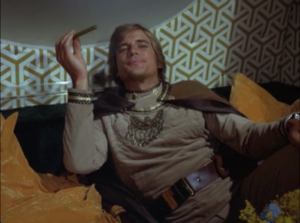
In fact, I’m rather impressed with what they managed to achieve on a 1970s TV show budget when it comes to producing the thrilling dogfights between the Vipers and the Cylon fighters.
(Although, this achievement is somewhat tarnished by the knowledge that the film Space Mutiny, which was hilariously skewered on Mystery Science Theater 3000, shamelessly reused the exact same footage for its own space sequences, which regrettably influences my perception.)
While the glimpses we catch of the Cylons reveal somewhat clunky designs, their faceless appearance carries an air of menace that effectively conveys the fear instilled in the convoy.
Additionally, I appreciate the haphazard look of the fleet in the few exterior shots we receive.
It gives the impression of a group less like a uniform entity and more like one that’s working hard to hold itself together.
My primary concern with the show lies in its lack of tonal consistency.
The series revolves around the premise of the Colonial Fleet venturing into the unknown in search of a new home while constantly being pursued by the menacing Cylon forces, a situation one would expect to keep everyone on edge at all times.
However, there are instances that seem at odds with this tension.
For example, you have Starbuck attempting a Three’s Company-style juggling act with two simultaneous dates, one of whom happens to be the daughter and sister of his respective commanding officers, a decision that appears particularly ill-conceived.
Additionally, you witness Commander Adama assuming the role of a benevolent grandfather as he tells Boxer a bedtime story, which seems out of place given the circumstances.
Then there’s Starbuck trying to work a get-rich-quick scheme into a mission of utmost importance. The personality of Starbuck’s on-board computer, CORA, strikes me as resembling HAL 9000’s more flirtatious sibling.
And, of course, there’s Muffit, that nightmarish robotic creature that combines elements of a dog and a monkey, causing me to involuntarily react with a scream every time it makes an appearance on screen.
While it’s possible for a series to incorporate all these elements, the execution falls short of unifying them into a cohesive whole, leaving the show feeling disjointed.
The lack of focus in the episode is particularly frustrating because it seems to contain some intriguing concepts beneath the surface.
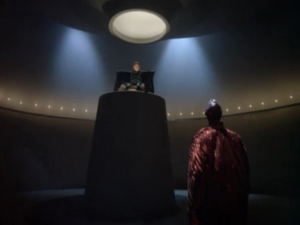
A significant revelation in the episode is that the inhabitants of the Proteus colony are, in fact, the descendants of the original settlers who are living out identical roles without any complaints or questions.
They are completely oblivious to the destruction of the Twelve Colonies and the fact that the fruits of their labor are merely gathering dust on the flight deck.
Just last month, I came across a fascinating article in Smithsonian about a family that lived in isolation in Siberia for 42 years, and this episode presents an interesting extension of that idea on a much larger scale.
We’ve previously discussed how the vast distances and isolation of space make it an ideal setting for horror and adventure scenarios, and this episode further underscores the notion that in the void of space, entire planets could vanish from the grid at any moment.
However, by the episode’s conclusion, it appears that all tensions are conveniently swept aside as both prisoners and enforcers enthusiastically celebrate the destruction of the Cylons by the Vipers.
In the closing scene, it seems they’ve been integrated into the Colonial Fleet, with their primary grievance being the quality of the ambrosia. (On a side note, there’s a significant amount of emotional attachment to that, considering that last week a hat was shot and now we’re witnessing the destruction of liquor.
These shows seem determined to tug at my heartstrings.)
*Here’s a fun piece of trivia related to This Was TV: one of the prisoners is portrayed by Arlene Martel, whom dedicated roundtable readers may recall as Robert Culp’s love interest in The Outer Limits episode “Demon With a Glass Hand.” It seems that between Mr. Trent and Cylons, humanoid robots just won’t give her a break.
As we approach the conclusion of this roundtable series, it’s safe to say that the expectations for the Battlestar reboot have been significantly tempered by the experience of “The Long Patrol.”
I wouldn’t go as far as to say that I despised it, but unlike our previous two entries, this is a show that would require some deliberate effort on my part to continue watching.
Also Read: Roundtable Review: Taxi, “Come As You Aren’t” and “High School Reunion”
Nirajan: Oh, Reesav, you beat me to the punch with the Space Mutiny reference! I spent the entire episode waiting for Blast Hardcheese to make an appearance.
One of the most significant issues for me, aside from the erratic shifts in tone, uneven performances, and the awkward pacing, is how the characters appear to have completely disregarded the core concept of the series they inhabit.
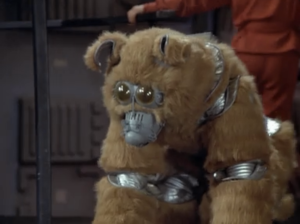
For instance, Starbuck is dispatched, unarmed, to another star system to investigate distant life signs, and when he actually encounters another human, his primary concern is how much profit he can make by selling the ambrosia the guy is smuggling.
This comes after the sitcom-like escapades with his two dates, during which Starbuck complains about the cost of his scheme in cubits, and that peculiar maitre d’ is amused by the amount of money being squandered.
I couldn’t help but wonder, why are they so fixated on money?
The show seems torn between being a narrative about a society on the brink of extinction and a flashy space opera for younger audiences, which ends up pushing the show’s fundamental premise into the background.
And when it does resurface, like when Boomer and Apollo express concerns about having to destroy Starbuck’s only means of returning to avoid the Cylons tracking the fleet, it results in jarring tonal shifts that don’t quite gel.
While I’m not well-versed in the show’s history, a part of me wants to believe that Glen A. Larson initially had a darker and more intricate vision for the series, but the success of Star Wars steered Galactica towards a more youth-oriented direction.
*I shared the same confusion regarding the stellar geography in this episode. Initially, I believed it was just another star system, but there’s a line from Starbuck where he mentions that he’s from another galaxy. However, this planet is described as an old Colonial settlement. Yet, it’s also depicted as being so distant that no human has ever ventured there. The inconsistency in the astronomical details left me thoroughly baffled. Perhaps it wasn’t just me who found it perplexing.
It’s indeed a bit perplexing to pinpoint the target audience for this episode.
The Star Wars aesthetic and the presence of Muffit, who is utterly nightmarish, would suggest that the show is geared toward a younger audience.
However, the central plot of the episode revolves around alcohol, and there are other aspects that seem more adult-oriented.
For example, the image of Starbuck incessantly puffing on a cigar throughout his double dates raises questions.
Additionally, the somewhat uncomfortably sexual nature of his relationship with the ship’s computer adds to the confusion about the intended audience.
In hindsight, I can imagine that if I were ten years older, I might have loved this as a kid in 1978.
Even if the plot is perplexing and the tone is all over the place, the episode doesn’t hold back on the thrilling spaceship scenes and gratuitous laser battles. (One memorable moment being when Apollo instructs Boomer not to shoot at the smuggler, only to have Apollo himself open fire on the guy less than six seconds later.)
In a world immediately following the release of Star Wars, I can understand how Battlestar Galactica might have found a place in the hearts of kids who were craving more of the real thing and were willing to settle for this budget-friendly imitation.
But let’s not forget the lingering mystery: what on Earth was Muffit supposed to be, anyway? It appeared as though a Xenomorph had somehow been incubated inside a Teddy Ruxpin.
Gives me shivers just thinking about it.
Muskan: I completely understand your desire to be fair when assessing the original series, especially when you hold the reboot in such high regard.
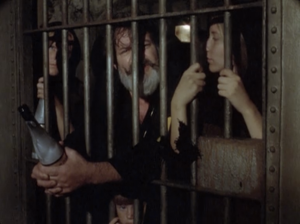
The “Space Irish” element is a head-scratcher, and it’s intriguing to think about how the show stumbled upon a potentially compelling story with a very Catholic treatment of Space Original Sin, yet didn’t fully explore it.
It’s almost like they had a great idea but couldn’t quite grasp its full potential.
You’re right; expecting a Star Wars knock-off to delve into a moody examination of genocide and moral dilemmas is a bit like going to Burger King and demanding lobster.
While the stale sitcom-style “two dates? Oh boy!” antics might not be everyone’s cup of tea, it’s worth acknowledging the generally upbeat mood among the characters despite the dire circumstances they face.
Buck Rogers also had a grim premise it chose to overlook, and it managed to pull it off more successfully than Galactica.
The original Battlestar Galactica was clearly aiming to captivate the inner ten-year-old in all of us, who longed to see robots, spaceships, and robots flying spaceships.
In that regard, it succeeded and continues to be remembered fondly for good reason.
As for your theory about Muffit being the Fifth Cylon, it’s a fascinating concept that could have added an extra layer of intrigue to the series!
Sadhana: The original Battlestar Galactica seems to share a common issue that sometimes affects the revived Doctor Who.
The multi-part episodes can feel somewhat lacking in plot ideas, leading to dull filler material that leaves viewers unengaged.
On the other hand, the standalone episodes often overwhelm with their concepts, making it challenging to digest them fully.
While the ideas presented in “The Long Patrol” aren’t all bad, it’s the execution that truly matters.
In contrast, what made Star Wars so exceptional is that George Lucas recognized that being family-friendly didn’t necessitate featuring an actual family in the story (we’re specifically referring to A New Hope here).
This is a key issue with broadcast television, as it tends to insist on blood family ties, when high-concept storytelling can thrive by grounding itself in character connections that aren’t strictly familial.
Unfortunately, the original Battlestar Galactica is preoccupied with its sitcom-style ideas and the enigmatic Muffits, making it miss the mark on this concept.
The original series’ gender politics also come into question, and many of the issues in this area were effectively addressed in the reimagined series by Ron D. Moore and David Eick, who simply cast women in roles originally played by men.
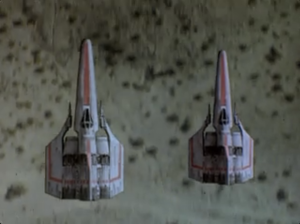
In essence, this encapsulates the essence of the original BSG: it was too preoccupied with emulating Star Wars to truly stand out, too focused on retelling war stories or recycling sitcom plots to delve into its character dynamics, and too rooted in being “of its time” to look forward to the future.
And as for Baltar, well, it seems we couldn’t avoid talking about him after all! (You jinxed it.)


